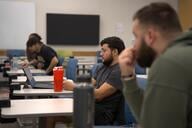You have /5 articles left.
Sign up for a free account or log in.
If the purpose of a college education is for students to learn, academe is failing, according to Academically Adrift: Limited Learning on College Campuses, a book being released today by University of Chicago Press.
The book cites data from student surveys and transcript analysis to show that many college students have minimal classwork expectations -- and then it tracks the academic gains (or stagnation) of 2,300 students of traditional college age enrolled at a range of four-year colleges and universities. The students took the Collegiate Learning Assessment (which is designed to measure gains in critical thinking, analytic reasoning and other "higher level" skills taught at college) at various points before and during their college educations, and the results are not encouraging:
- 45 percent of students "did not demonstrate any significant improvement in learning" during the first two years of college.
- 36 percent of students "did not demonstrate any significant improvement in learning" over four years of college.
- Those students who do show improvements tend to show only modest improvements. Students improved on average only 0.18 standard deviations over the first two years of college and 0.47 over four years. What this means is that a student who entered college in the 50th percentile of students in his or her cohort would move up to the 68th percentile four years later -- but that's the 68th percentile of a new group of freshmen who haven't experienced any college learning.
"How much are students actually learning in contemporary higher education? The answer for many undergraduates, we have concluded, is not much," write the authors, Richard Arum, professor of sociology and education at New York University, and Josipa Roksa, assistant professor of sociology at the University of Virginia. For many undergraduates, they write, "drifting through college without a clear sense of purpose is readily apparent."

The research findings at the core of the book are also being released today by their sponsor, the Social Science Research Council. (Esther Cho of the council is a co-author on that paper.)
The main culprit for lack of academic progress of students, according to the authors, is a lack of rigor. They review data from student surveys to show, for example, that 32 percent of students each semester do not take any courses with more than 40 pages of reading assigned a week, and that half don't take a single course in which they must write more than 20 pages over the course of a semester. Further, the authors note that students spend, on average, only about 12-14 hours a week studying, and that much of this time is studying in groups.
The research then goes on to find a direct relationship between rigor and gains in learning:
- Students who study by themselves for more hours each week gain more knowledge -- while those who spend more time studying in peer groups see diminishing gains.
- Students whose classes reflect high expectations (more than 40 pages of reading a week and more than 20 pages of writing a semester) gained more than other students.
- Students who spend more time in fraternities and sororities show smaller gains than other students.
- Students who engage in off-campus or extracurricular activities (including clubs and volunteer opportunities) have no notable gains or losses in learning.
- Students majoring in liberal arts fields see "significantly higher gains in critical thinking, complex reasoning, and writing skills over time than students in other fields of study." Students majoring in business, education, social work and communications showed the smallest gains. (The authors note that this could be more a reflection of more-demanding reading and writing assignments, on average, in the liberal arts courses than of the substance of the material.)
In section after section of the book and the research report, the authors focus on pushing students to work harder and worrying less about students' non-academic experiences. "[E]ducational practices associated with academic rigor improved student performance, while collegiate experiences associated with social engagement did not," the authors write.
In an interview, Arum said that the problems outlined in the book should be viewed as a moral challenge to higher education. Students who struggle to pay for college and emerge into a tough job market have a right to know that they have learned something, he said. "You can't have a democratic society when the elite -- the college-educated kids -- don't have these abilities to think critically," he said.
The book rejects the idea of federal mandates on testing or the curriculum, suggesting that such requirements rarely work. And the book acknowledges that many college educators and students don't yet see a crisis, given that students can enroll, earn good grades for four years, and graduate -- very much enjoying themselves in the process. But in an era when "the world has become unforgiving" to those who don't work hard or know how to think, Arum said that this may be a time to consider real change.
The culture of college needs to evolve, particularly with regard to "perverse institutional incentives" that reward colleges for enrolling and retaining students rather than for educating them. "It's a problem when higher education is driven by a student client model and institutions are chasing after bodies," he said.
The analysis in the book stresses that there is significant variation within institutions, not just among institutions, with students in some academic programs regularly outperforming others at the same campuses. Arum said this suggests that institutions can improve student learning by making sure that there is some consistency across disciplines in the rigor of requirements. "You need an internal culture that values learning," he said. "You have to have departments agree that they aren't handing out easy grades."
Further, he said that colleges need to shift attention away from measures of "social engagement" (everything that's not academic) and toward academic engagement, even if some of those measures of non-academic engagement help keep students engaged and enrolled. "It's a question of what outcome you want," he said. "If the outcome is student retention and student satisfaction, then engagement is a great strategy. If, however, you want to improve learning and enhance the academic substance of what you are up to, it is not necessarily a good strategy."
(If this sounds like a swipe at the National Survey of Student Engagement, Arum said it shouldn't be taken that way. He praises NSSE for asking questions that focus on the student experience, and says that many of NSSE's findings on the minimalist levels of academic work and studying are consistent with his own. Rather, he faults college administrators for paying little attention to those findings and more on NSSE measures of non-academic satisfaction.)
Arum acknowledged that the tough economy may be acting against reform, given that many professors report that increases in class size and course loads are leading them to cut down on the ambition of student assignments simply to keep up with grading. With fewer full-time positions, professors at many institutions "are overwhelmed," he said. But Arum challenged faculty members to be creative in finding ways to assign more writing and reading to students.
Distribution of the book is just starting, but there are signs it could generate buzz. The Social Science Research Council will host a panel this week in Washington featuring experts on assessment and higher education, with representatives from leading think tanks and foundations. The book will also be discussed at next week's meeting of the Association of American Colleges and Universities.
Debra Humphreys, vice president for communications and public affairs of AAC&U, said that she viewed the book as "devastating" in its critique of higher education. Faculty members and administrators (not to mention students and parents) should be alarmed by how little learning the authors found to be taking place, she said. Humphreys also said that the findings should give pause to those anxious to push students through and award more degrees -- without perhaps giving enough attention to what happens during a college education.
"In the race to completion, there is this assumption that a credit is a credit is a credit, and when you get to the magic number of credits, you will have learned what you need to learn," she said. What this book shows, Humphreys added, is that "you can accumulate an awful lot of credits and not learn anything."
AAC&U programs have in the past stressed the value of academic rigor and also of engagement of students outside the classroom. Humphreys said that she agreed with the book that some activities students enjoy may not add to their learning. But she said it was important not to view all engagement activities in the same way. It is important, she said, "not to lump together activities such as being in a fraternity or just hanging out with friends" with activities such as extracurricular activities that may in fact be quite educational and important, even if not linked to a specific course.
Students could benefit especially, she feels, from the point in the book about the variation among those at the same institution. "I don't think we are doing well enough at helping them understand that choices matter," she said. "Choices in the academic courses they take, how much they are working outside the classroom, how much they are studying, how much they are partying -- that balance is important."




